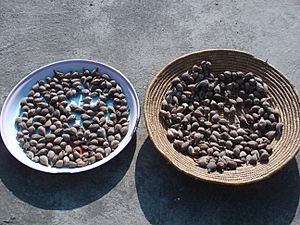Aframomum corrorima facts for kids
Quick facts for kids Aframomum corrorima |
|
|---|---|
 |
|
| Dried korarima fruits, ready for making berbere | |
| Conservation status | |
| Scientific classification | |
| Genus: |
Aframomum
|
| Species: |
corrorima
|
| Synonyms | |
|
|
Aframomum corrorima is a plant that belongs to the ginger family, called Zingiberaceae. It's a type of flowering plant that grows year after year. This plant is known by several names, like Ethiopian cardamom, false cardamom, or korarima.
The plant grows tall, usually about 1 to 2 meters (3 to 6 feet) high. It has leafy stems that come from roots that spread underground, similar to ginger roots. Its leaves are dark green and shaped like an oval, about 10–30 cm long. Pink flowers grow close to the ground. These flowers later turn into red, soft fruits. Inside the fruits are shiny brown seeds, which are usually small, about 3–5 mm wide.
The Spice: Korarima
The spice we call korarima comes from the plant's seeds. These seeds are usually dried before they are used. Korarima is a very important spice in Ethiopian and Eritrean cuisine.
It is a key ingredient in many famous spice mixes. These include berbere, mitmita, and awaze. People also use korarima to add flavor to coffee. Its taste is much like green cardamom, which is a closely related spice. In traditional Ethiopian herbal medicine, the seeds are sometimes used to help with digestion or as a general tonic.
Where Korarima Grows
This plant naturally grows in certain parts of Africa. You can find it in Tanzania, western Ethiopia (near Lake Tana and Gelemso), southwestern Sudan, and western Uganda.
Even though it grows wild in these areas, people also cultivate it in Ethiopia and Eritrea. However, many of the fruits are still collected from wild plants. The dried fruits are sold widely in markets and can be quite expensive. Fresh fruits are mostly sold in the areas where they are grown.
See also
 In Spanish: Aframomum corrorima para niños
In Spanish: Aframomum corrorima para niños




